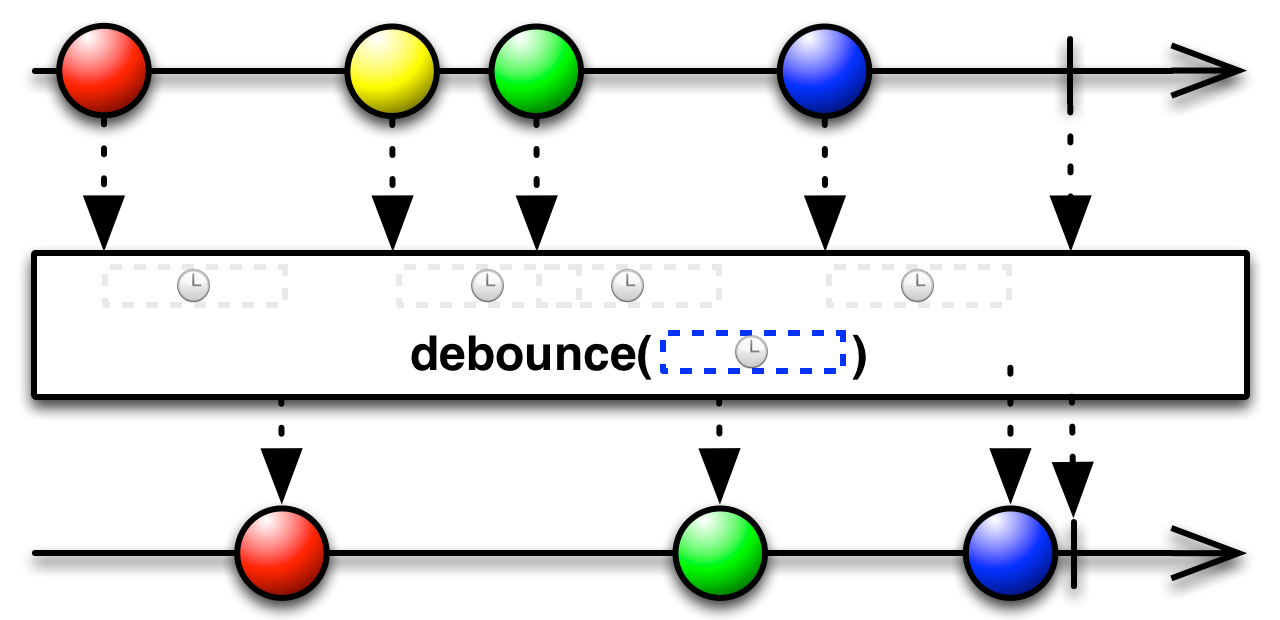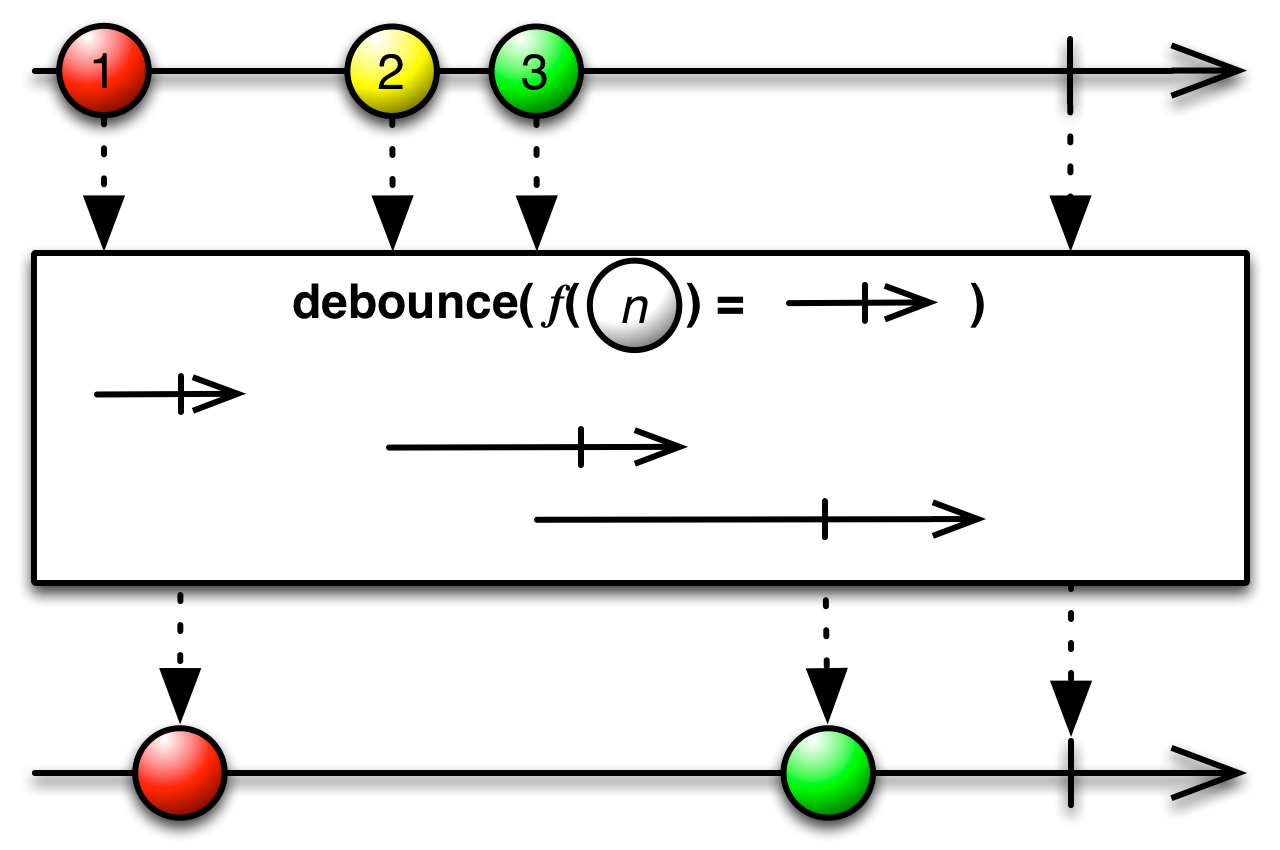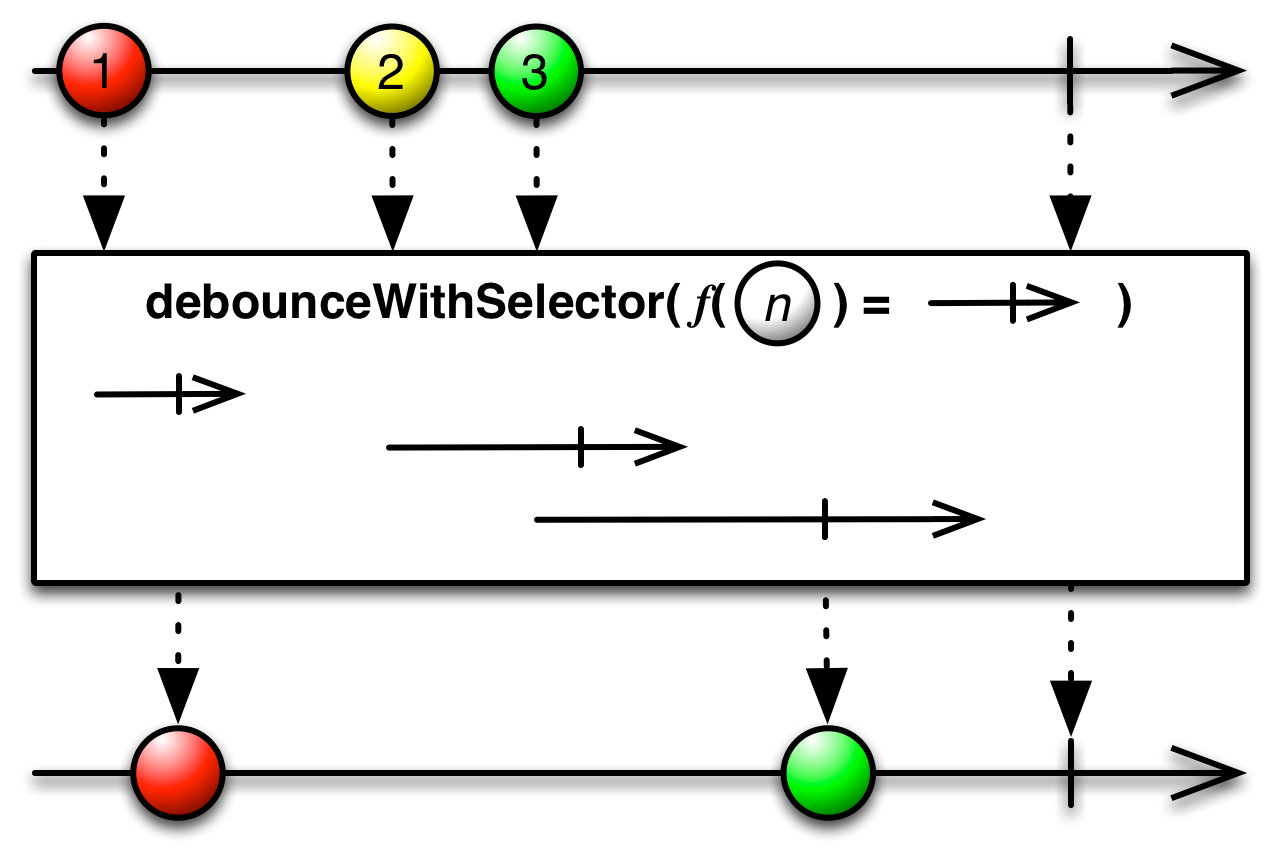The Debounce operator filters out items emitted by the source Observable that are rapidly followed by another emitted item.
debouncedebounceWithSelectorTBD
TBD
RxGroovy implements this operator as throttleWithTimeout and debounce.
Note that the last item emitted by the source Observable will be emitted in turn by this operator even if
the source Observable’s onCompleted notification is issued within the time window you
specify since that item’s emission. That is to say: an onCompleted notification will
not trigger a throttle.

One variant of throtleWithTimeout/debounce (two names for the same operator
variant) throttles at a periodic time interval that you choose by passing in a TimeUnit and
a quantity of such units as parameters to the operator.
This variant operates by default on the computation
Scheduler, but you can optionally pass in a Scheduler of your choosing as
a third parameter.

There ia also a variant of debounce (that does not have a throttleWithTimeout
alias) that throttles the source Observable by applying a function to each item it emits, this function
generating an Observable. If the source Observable emits another item before this newly-generated
Observable terminates, debounce will suppress the item.
This variant of debounce does not by default operate on any particular
Scheduler.
debounce(Func1)
RxJava implements this operator as throttleWithTimeout and debounce.
Note that the last item emitted by the source Observable will be emitted in turn by this operator even if
the source Observable’s onCompleted notification is issued within the time window you
specify since that item’s emission. That is to say: an onCompleted notification will
not trigger a throttle.

One variant of throtleWithTimeout/debounce (two names for the same operator
variant) throttles at a periodic time interval that you choose by passing in a TimeUnit and
a quantity of such units as parameters to the operator.
This variant operates by default on the computation
Scheduler, but you can optionally pass in a Scheduler of your choosing as
a third parameter.

There ia also a variant of debounce (that does not have a throttleWithTimeout
alias) that throttles the source Observable by applying a function to each item it emits, this function
generating an Observable. If the source Observable emits another item before this newly-generated
Observable terminates, debounce will suppress the item.
This variant of debounce does not by default operate on any particular
Scheduler.
debounce(Func1)
The first variant — called either debounce or throttleWithTimeout —
accepts as its parameter a duration, defined as an integer number of milliseconds, and it suppresses any
emitted items that are followed by other emitted items during that duration since the first item’s
emission.
var times = [
{ value: 0, time: 100 },
{ value: 1, time: 600 },
{ value: 2, time: 400 },
{ value: 3, time: 700 },
{ value: 4, time: 200 }
];
// Delay each item by time and project value;
var source = Rx.Observable.from(times)
.flatMap(function (item) {
return Rx.Observable
.of(item.value)
.delay(item.time);
})
.debounce(500 /* ms */);
var subscription = source.subscribe(
function (x) {
console.log('Next: %s', x);
},
function (err) {
console.log('Error: %s', err);
},
function () {
console.log('Completed');
});Next: 0 Next: 2 Next: 4 Completed

The debounceWithSelector operator throttles the source Observable by applying a function to
each item it emits, this function generating an Observable. If the source Observable emits another item
before this newly-generated Observable terminates, debounce will suppress the item.
var array = [
800,
700,
600,
500
];
var source = Rx.Observable.for(
array,
function (x) {
return Rx.Observable.timer(x)
})
.map(function(x, i) { return i; })
.throttleWithSelector(function (x) {
return Rx.Observable.timer(700);
});
var subscription = source.subscribe(
function (x) {
console.log('Next: ' + x);
},
function (err) {
console.log('Error: ' + err);
},
function () {
console.log('Completed');
});Next: 0 Next: 3 Completed
debounce and debounceWithSelector are found in each of the following
distributions:
rx.all.jsrx.all.compat.jsrx.time.js (requires rx.js or rx.compat.js)rx.lite.jsrx.lite.compat.jsTBD
RxPHP implements this operator as throttle.
Returns an Observable that emits only the first item emitted by the source Observable during sequential time windows of a specified duration. If items are emitted on the source observable prior to the expiration of the time period, the last item emitted on the source observable will be emitted.
//from https://github.com/ReactiveX/RxPHP/blob/master/demo/throttle/throttle.php
$times = [
['value' => 0, 'time' => 10],
['value' => 1, 'time' => 200],
['value' => 2, 'time' => 400],
['value' => 3, 'time' => 500],
['value' => 4, 'time' => 900]
];
// Delay each item by time and project value;
$source = Observable::fromArray($times)
->flatMap(function ($item) {
return Observable::of($item['value'])
->delay($item['time']);
})
->throttle(300 /* ms */);
$subscription = $source->subscribe($stdoutObserver);
Next value: 0
Next value: 1
Next value: 3
Next value: 4
Complete!
TBD